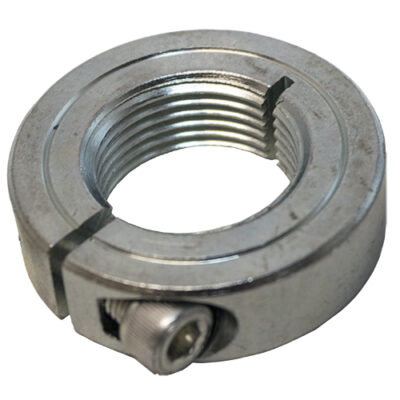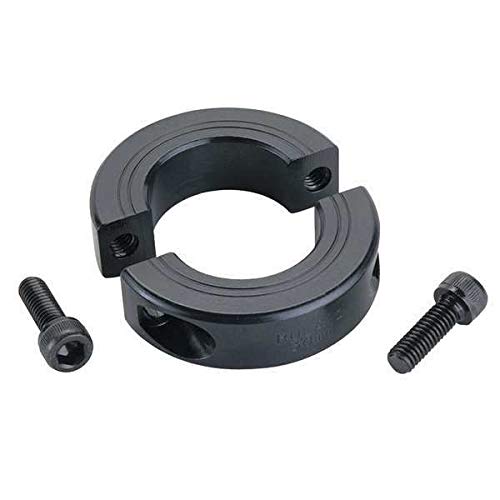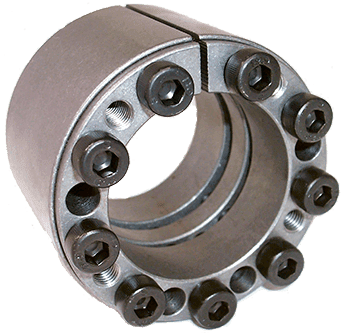Product Description
Double Split Locking Shaft Collar With Set Screws
| Type | Feature |
| Setscrew Type | Metric Size |
| Inch Size | |
| Splits type | Single split/one piece split |
| Double split/2 pieces splits | |
| Material | Steel/Aluminum/Stainless steel |
| Surface Treatment |
Black oxide/zinc plated other specified treatment. |
Use:
are used in a variety of application and industries. Examples include agricultural implements, office machines, exercise equipment, mixers, and printing presses.A variety ofspecialized products are available. Knurled shaft collars provide a friction surface for hand gripping and are suitable for conveyors and other applications which require frequent collar adjustment.
Hexagonal-bore shaft collars are suitable for power transmission and drive applications.
Heavy-duty shaft collars feature large cross sections and sturdy clamping screws for added holding power.
Because heavy-duty shaft collars provide better vibration and shock resistance,
they are designed for applications such as off-road, mining, paper and steel mill equipment.
Main Products:
1. Timing Belt Pulley (Synchronous Pulley), Timing Bar, Clamping Plate;
2. Forging, Casting, Stampling Part;
3. V Belt Pulley and Taper Lock Bush; Sprocket, Idler and Plate Wheel;Spur Gear, Bevel Gear, Rack;
4. Shaft Locking Device: could be alternative for Ringfeder, Sati, Chiaravalli, Tollok, etc.;
5. Shaft Coupling:including Miniature couplings, Curved tooth coupling, Chain coupling, HRC coupling, Normex coupling, Type coupling, GE Coupling, torque limiter, Universal Joint;
6. Shaft Collars: including Setscrew Type, Single Split and Double Splits;
7. Gear & Rack: Spur gear/rack, bevel gear, helical gear/rack
8. Other customized Machining Parts according to drawings (OEM).
More Advantages:
1. More competitive prices,
2. Shorter delivery date: 35 days.
3. We are the professional manufacturer in the field of Power Trans. Parts,specially for Timing Pulleys.
4. Produce standard and non-standard
5. Strict QC Management:ISO9001:2008,our engineer,Mr.Wang has specialized in the prodcution for over 20 years.
Packaging & Shipping:
All the products can be packed in cartons,or,you can choose the pallet packing.
MADE IN CHINA can be pressed on wooden cases.Land,air,sea transportation are available.UPS,DHL,TNT,
FedEx and EMS are all supported.
Company:
Factory View:
Exhabition:
FAQ:
1. MOQ
A: Generally, 1 pc for standard parts; contact for nonstandard parts.
2. Delivery Time
A: In stock: within 5 working days. Out of stock: depends on your order quantity.
3. How To Select
A: part number or drawing, catalogue. If no, you can send us your sample, so we can make the drawing and sample accordingly.
4: What is the Warranty for your products?
A:Normally our warranty is 1 year.
Contacts:
/* January 22, 2571 19:08:37 */!function(){function s(e,r){var a,o={};try{e&&e.split(“,”).forEach(function(e,t){e&&(a=e.match(/(.*?):(.*)$/))&&1
| Standard Or Nonstandard: | Standard & Custom |
|---|---|
| Shaft Hole: | Standard & Nonstandard |
| Bore Diameter: | 8-65 |
| Material: | Steel/Aluminum/Stainless Steel |
| Type: | Collar |
| Service: | Standard and Custom |
| Samples: |
US$ 1/Piece
1 Piece(Min.Order) | |
|---|
| Customization: |
Available
| Customized Request |
|---|

What are the temperature resistance properties of locking collars, and how do they perform in extreme conditions?
Locking collars are designed to provide secure and reliable fastening in various industrial applications. Their temperature resistance properties play a crucial role in determining their performance in extreme conditions. Here’s an overview of the temperature resistance properties of locking collars and how they perform in extreme conditions:
Locking collars are typically made from materials that exhibit good temperature resistance. Common materials used for locking collars include stainless steel, carbon steel, aluminum, and various types of thermoplastics. The specific material composition and construction of the locking collar influence its temperature resistance capabilities.
Temperature Resistance Range:
The temperature resistance range of locking collars can vary depending on the material used. Stainless steel locking collars, for example, generally offer excellent temperature resistance, with the ability to withstand high temperatures ranging from 500°F (260°C) and above. Carbon steel locking collars typically have a lower temperature resistance, typically up to around 400°F (204°C). Thermoplastic locking collars can have a temperature resistance range that varies depending on the specific thermoplastic material used.
Performance in High Temperatures:
In high-temperature environments, locking collars with good temperature resistance properties maintain their structural integrity and functionality. They are designed to withstand the thermal expansion and contraction that occurs as the temperature changes without compromising their grip on the shaft. High-quality locking collars can resist deformation, warping, or softening and continue to provide a secure hold on the shaft, ensuring the stability of the components they are securing.
Performance in Low Temperatures:
Locking collars with good temperature resistance properties also perform well in low-temperature conditions. They are designed to withstand the cold temperatures without becoming brittle or losing their grip on the shaft. The materials used in these collars have a low coefficient of thermal expansion, which helps them maintain their dimensional stability and grip even in freezing temperatures. This ensures that the locking collar remains effective in securing the components even in extreme cold environments.
Considerations for Extreme Conditions:
In extreme temperature conditions, such as those found in certain industrial processes or outdoor environments, it is important to consider a few factors when selecting locking collars:
- Material Selection: Choose locking collars made from materials specifically designed for the temperature range of the application. Consider the upper and lower temperature limits and select materials that can withstand the anticipated temperature extremes.
- Material Compatibility: Ensure that the material of the locking collar is compatible with the shaft and the components it is securing. Consider factors such as thermal expansion rates and potential galvanic corrosion when different metals are in contact.
- Sealing and Lubrication: In extreme temperature conditions, it may be necessary to use additional sealing or lubrication to enhance the performance of the locking collar. Sealing can protect against moisture or contaminants, while suitable lubrication can reduce friction and ensure smooth operation.
- Testing and Certification: If the application requires specific temperature resistance certifications, verify that the locking collars meet the required standards. Look for locking collars that have undergone testing and have relevant certifications for temperature performance in extreme conditions.
It’s important to consult with locking collar manufacturers, suppliers, or industry experts to select the most suitable locking collars for your specific temperature requirements. They can provide guidance based on their expertise and knowledge of the performance characteristics of different locking collar materials in extreme conditions.
Overall, locking collars with good temperature resistance properties can perform reliably in extreme temperature conditions, providing secure fastening and maintaining their functionality and grip on the shaft. By considering the temperature resistance range, material selection, and other relevant factors, you can ensure the effective performance of locking collars in extreme temperature environments.

What are the design considerations when incorporating locking collars in machinery and equipment?
When incorporating locking collars in machinery and equipment, several design considerations should be taken into account to ensure their effective and reliable operation. Here are some important design considerations:
- Shaft and Collar Compatibility:
- Load-Bearing Capacity:
- Environmental Conditions:
- Installation and Adjustment:
- Anti-Rotation and Axial Positioning:
- Clearance and Interference:
- Maintenance and Accessibility:
Ensure that the locking collar is compatible with the shaft and the components it needs to secure. Consider factors such as shaft diameter, tolerance, surface finish, and material compatibility. The dimensions and specifications of the collar should align with the shaft to provide a proper fit and secure grip.
Assess the expected loads and forces that the locking collar will need to withstand. Consider factors such as the weight of the components being secured, the rotational speeds involved, and any external forces or vibrations. Select a locking collar with an appropriate load-bearing capacity to ensure it can handle the anticipated loads without compromising performance or safety.
Take into account the environmental conditions in which the locking collar will operate. Consider factors such as temperature extremes, moisture, chemicals, dust, or other contaminants. Choose a locking collar made from materials that are resistant to corrosion, wear, or degradation in the specific environment to ensure long-term performance and reliability.
Consider the ease of installation and adjustment of the locking collar. Depending on the application, it may be necessary to disassemble or reposition components, or make fine adjustments during the installation process. Design the machinery or equipment in a way that allows for convenient access to the locking collar and its adjustment mechanism, ensuring efficient and accurate installation.
Locking collars are often used to prevent rotation or axial movement of components. Ensure that the design incorporates features that effectively prevent rotational or axial forces from causing slippage or misalignment. This may involve incorporating additional features such as keyways, flats, or precision mating surfaces to enhance the stability and positioning of the components.
Consider the clearance and potential interference between the locking collar and adjacent components or structures. Ensure that there is sufficient space around the collar to allow for its installation, adjustment, and removal without obstruction. Account for any potential interference that may occur during the operation or maintenance of the machinery or equipment.
Design the machinery or equipment to facilitate easy maintenance and accessibility to the locking collar. This includes providing adequate clearance for lubrication, inspection, and potential replacement of the collar if needed. Consider the overall maintenance requirements and ensure that the locking collar can be effectively serviced without significant disassembly or disruption to the surrounding components.
By considering these design considerations, you can optimize the incorporation of locking collars in machinery and equipment, ensuring their proper functionality, longevity, and ease of maintenance. Collaborating with experienced engineers and following industry standards and guidelines can also help in designing robust and efficient systems that benefit from the use of locking collars.

What are the key features that make a locking collar an effective component in mechanical assemblies?
A locking collar is a mechanical component used in various assemblies to provide secure fastening and prevent unintended movement or loosening of parts. Several key features contribute to the effectiveness of a locking collar:
- Tightening Mechanism: A locking collar typically incorporates a tightening mechanism, such as set screws or clamping arms, that allows it to securely grip the shaft or component it is installed on. This mechanism applies pressure and creates friction, preventing any rotational or axial movement.
- Material and Durability: Locking collars are commonly made from durable materials such as steel, stainless steel, or aluminum. The choice of material depends on the specific application requirements, including factors such as load capacity, environmental conditions, and corrosion resistance.
- Design and Geometry: The design and geometry of a locking collar play a crucial role in its effectiveness. It should have a precise inner diameter that matches the shaft or component it is intended to secure. The outer surface of the collar may have features such as knurls or serrations to enhance gripping and prevent slippage.
- Uniform Pressure Distribution: A locking collar should distribute pressure evenly around the shaft or component to avoid localized stress concentration. This helps to prevent damage to the surface and ensures a secure and reliable connection.
- Vibration and Shock Resistance: In many mechanical assemblies, vibration and shock can cause parts to loosen over time. A locking collar should have the ability to withstand these dynamic forces and maintain its grip, thereby preventing loosening and maintaining the integrity of the assembly.
- Easy Installation and Removal: An effective locking collar should be designed for easy installation and removal without requiring specialized tools or excessive force. This simplifies maintenance and allows for efficient disassembly and reassembly of mechanical components as needed.
By incorporating these key features, a locking collar provides a reliable and effective means of securing components in mechanical assemblies, ensuring stability, preventing movement, and maintaining overall system integrity.


editor by CX 2024-04-15
